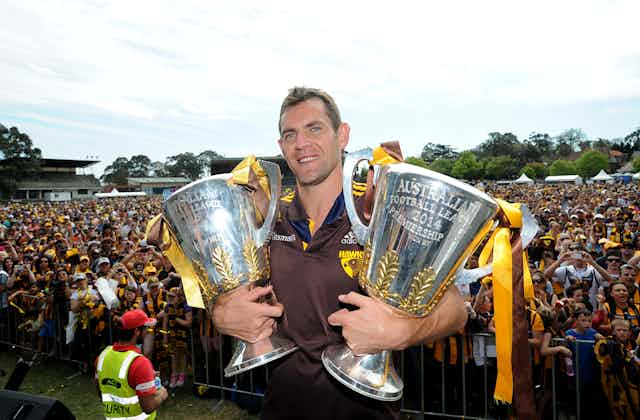The Australian Football League’s (AFL) fan base keeps growing and growing, whether measured by total attendances, total TV audiences, or the billions of dollars the league is able to command for its “product”. So what is it the barrackers are getting that keeps them coming back?
You only have to be at a game for a few minutes, or observe the way dedicated fans watch on TV or mobile phones or listen on radio, to see that footy adds a lot of passion to a lot of lives. That’s important, but it’s not all that footy serves up. It also promotes a bizarre type of optimism that serves society well, the type of “keep going no matter what the odds” mentality that Australia has relied upon in the darkest times of its short history, especially the two world wars and the great depression.
By this mentality, gathering glory is not the be all and end all of a life well lived – that’s sometimes frowned upon. What’s much more important is the stoic willingness to stare down hard times by shovelling gravel (usually only metaphorically) in the hope of building something better, even if the “better” turns out to be more shovelling alongside other like-minded people.
In other words, it might be that being a footy fan is not mainly about the glory of a premiership, which by this logic can be said to be all-too-fleeting. It is much more about enjoying the gravel-shovelling entailed in each and every season your club goes without a premiership, in the hope that it will help you build a better season next year, even though for many clubs “next year” keeps stretching into the never-never.
Having typed those words I can immediately hear the derision of many readers:
You wanker, you must barrack for one of the successful teams, you have no idea what it’s really like!
That may well be true, but nonetheless the hard evidence is pretty clear. Even the three clubs with the highest glory-to-gravel ratio – that is, the percentage of premiership seasons to non-premiership seasons – have, for this week at least, less than 14% glory. Carlton and Essendon, both foundation clubs in 1897, have 13.6% glory to 86.4% gravel.
Hawthorn, which entered the competition in 1925, has 13.3% glory to 86.7% gravel. They will move to the top if they win on Saturday, but their ratio will shift up only one percentage point: 14.3% to 85.7%. And to demonstrate what an important Grand Final it is, if West Coast win they will move to the top, but similarly their new placing won’t damage my main point: they’ll leap only to a ratio of 13.8% to 86.2%.
That’s right – even for the mightiest of clubs, more than 85% of the years they’ve sweated, strained, and endured broken bodies (and that’s just the fans) their reward has mostly been gravel piled upon gravel.
As for the other 14 clubs? Well, the news is either depressing or gratifying, depending on how much of my argument you’re prepared to buy.
Here’s the full glory-to-gravel ladder up to the end of the 2014 season. I’ll leave it for the readers to fully update the ladder after this weekend’s Grand Final brings the season officially to an end. Have your shovels ready.
That surely speaks for itself.
Another piece of grist for my proposition about footy-following building stoic resolve is the length of the gravel roads many clubs have built for themselves (and these figures do include 2015).

In this regard, St Kilda’s fans might be thought to be the league’s true champions. The Saints entered the competition in 1897 and won their only premiership in 1966. That means they have two long gravel roads to their credit. The first was 69 years long and the second one measures 49 years and counting.
That sounds impressive, but one other club beats the 69 and four other clubs beat the 49. South Melbourne endured 72 years (and a relocation to Sydney) between their flag in 1933 and their next one in 2005, so they are the record-holders.
The Western Bulldogs/Footscray head the 50-plus group. They didn’t enter the competition until 1925, picked up a premiership after a mere 29-year wait, but since then have built a gravel road that’s now 61 years long. They finished this season so well it may be that this admirable run will finish next year, but with their record that’s debatable, at very least.
Melbourne last won a flag in 1964, so now have a gravel track stretching back 51 years. That just edges out North Melbourne’s early effort; they entered in 1925 and won their first flag in 1975.
Fans of these six clubs must cackle with derision whenever they hear Fremantle supporters complain about 20 years without a flag (now 21). If Freo wants to join this seriously gravel-hardened group they’ve got at least another 30 consecutive years of shovelling ahead of them.

